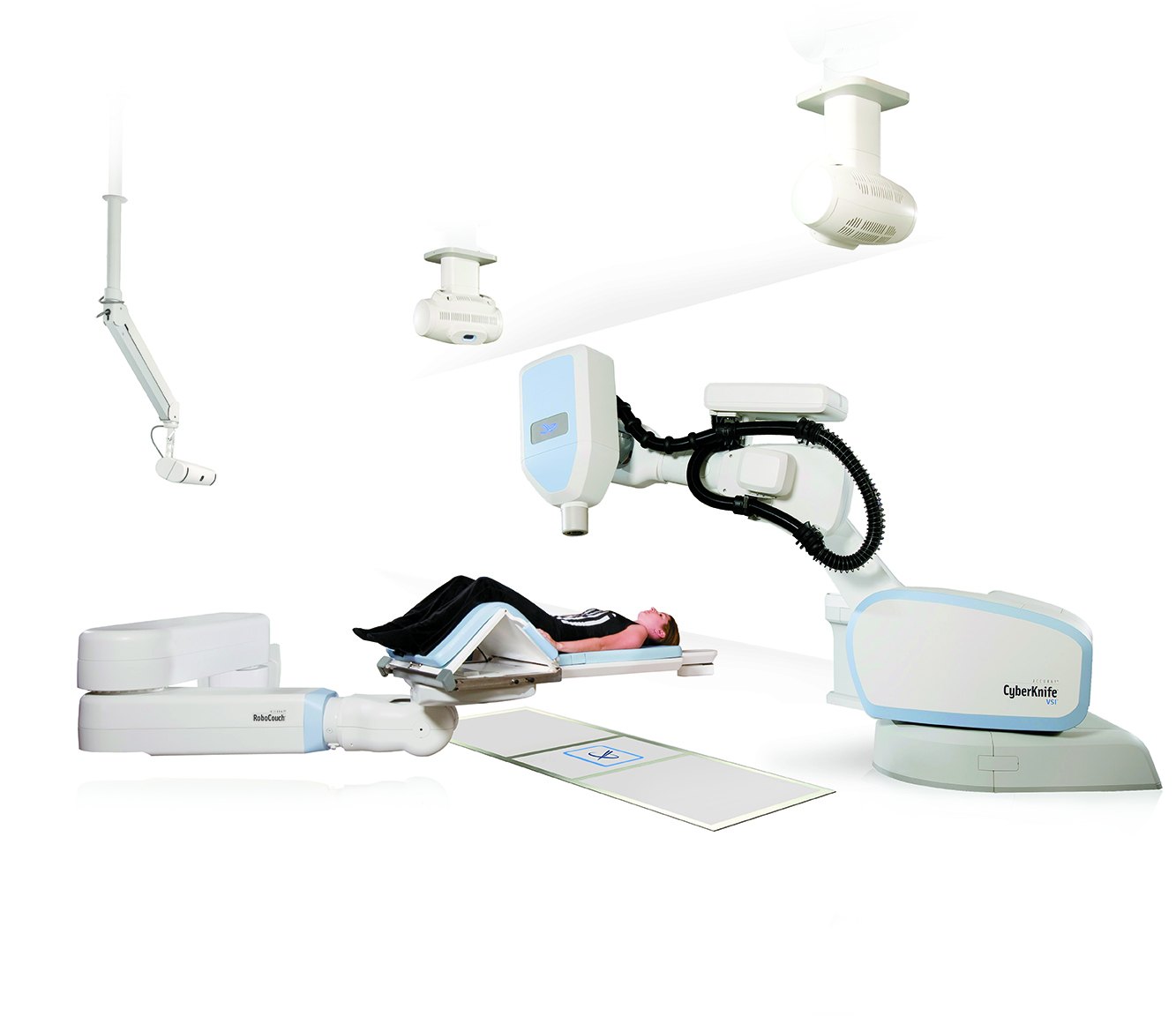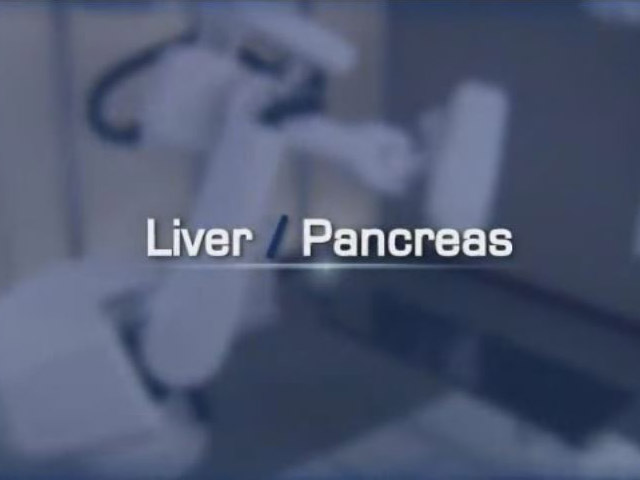PANCREATIC CANCER
CyberKnife Shows Promise in Delivering Painless, Non-Invasive Treatment for Pancreatic Cancer
For patients with pancreatic cancer, the most common treatment is surgery, often referred to as the Whipple Procedure. However, even when tumors are completely removed, about half of patients experience a recurrence of their cancer. Clinical studies have shown that surgery results in a media survival rate of about 11 months, with about 20 percent of patients surviving two years.
As alternative to the Whipple Procedure alone, doctors have been combining surgery with post-operative external beam radiation therapy (XRT) and chemotherapy. Clinical studies have shown that this combination of treatments can reduce the recurrence rate of local-regional pancreatic cancer and modestly improve survival.
In recent years, there has been interest in the effectiveness of XRT and chemotherapy alone or prior to surgery. However, studies have not shown that this approach improves survival compared to doing XRT and chemotherapy after surgery.
Another approach is intensity modulated radiation therapy (IMRT). With IMRT, a higher radiation dose can be delivered to the tumor, while minimizing exposure of healthy surrounding tissue and organs, compared with conventional XRT. It is believed that these unique capabilities should result in higher tumor control, improved long-term survival and decreased complications. These treatments are typically delivered on a daily basis over the course of five weeks.
Stereotactic body radiation therapy (SBRT) employs image-guided IMRT (IG-IMRT), which enables treatments to be completed in just one to five sessions taking place of the course of one week. SBRT enables oncologists to deliver a considerably higher dose of radiation with extreme precision, leading to improved tumor control, and in turn improved survival.
The CyberKnife System has been shown to be the SBRT delivery system providing the most accurate radiation dose delivery. As a result, the CyberKnife System enables clinicians to give the maximum dose to the tumor target while minimizing dose to surrounding normal tissues.
The non-invasive, non-surgical nature of the CyberKnife System, treatments are often preferred for patients who have other health concerns and cannot undergo surgery. CyberKnife treatments are given daily for up to five days, on an outpatient basis. The treatments are painless and each session takes only about 45 minutes to deliver, resulting in fewer complications and minimal side effects when compared to other pancreatic cancer treatment options.
About the Technology
At Phoenix CyberKnife and Radiation Oncology Center, we provide the latest technology in radiation therapy with the CyberKnife System. CyberKnife is a non-invasive alternative to surgery and is a clinically proven radiotherapy treatment for pancreatic cancer. The CyberKnife System uses robotic and tumor-tracking technology to deliver high doses of radiation to tumors, including pancreatic tumors. Recovery time is reduced significantly since CyberKnife is used on an outpatient basis.

Some of the many benefits of receiving pancreatic cancer treatment with CyberKnife include:
- Pinpoint accuracy - CyberKnife’s ability to track and target the tumor’s exact location ensures sub-millimeter accuracy, which reduces exposure to other healthy surrounding tissues, organs, and structures.
- Real-time imaging and motion-tracking technology make CyberKnife the most accurate form of radiation therapy.
- Non-invasive and non-surgical - There is no cutting or pain during treatment. The patient simply lies down while the robotic system delivers radiation to the tumor from multiple angles.
- Outpatient treatment - With CyberKnife, the patient completes their treatment in one to five sessions that are performed within one week. Once treatment is finished, the patient carries one with their normal daily life.
Another benefit of CyberKnife is it can be used as a standalone treatment plan or in conjunction with other treatments, such as chemotherapy or surgery. However, CyberKnife has brought new hope to pancreatic cancer patients whose tumors are inoperable due to poor health or other complications.
Advanced Motion Tracking
Historically, using conventional radiation therapy to treat pancreatic cancer has been problematic due to the subtle movements of the tumor with regular breathing. In many cases, patients were required to hold their breath or wear uncomfortable hardware to help stabilize their body during treatment. Even with these precautions, exposure to other organs and tissues is a possibility because of the tumor’s movements.
What sets the CyberKnife System apart from other radiotherapy technologies is its ability to track the tumor’s subtle movements during treatment. Using real-time image guidance and tumor-tracking software, the CyberKnife’s advanced robotic technology targets the tumor before each beam of radiation is delivered. This precision ensures sub-millimeter accuracy directly at the tumor while minimizing exposure to other organs and tissues.
Thanks to this extreme accuracy, treatment with CyberKnife is completed in one to five sessions within one week’s time, allowing the patient both a quicker treatment period and recovery time.
Pancreatic Treatment Process with CyberKnife
As opposed to conventional radiation therapy treatments, CyberKnife treatment is completed in a much shorter time span. With CyberKnife, you will receive one to five treatments in consecutive days, allowing you to continue with your daily routine. Treatment is pain-free and non-invasive, with improved patient outcome.
When working with our team at Phoenix CyberKnife, you will have fiducials inserted into the tumor to serve as a reference point for the tumor’s location. You will then undergo a CT scan, which will provide advanced images of your tumor and its location. Following imaging, a board-certified radiation oncologist will carefully customize your treatment plan.
During treatment, patients lie on the treatment couch while breathing naturally while the CyberKnife System does the work with extreme precision.
Once your treatment session has been performed, you are welcome to go home and resume your normal daily activities. It's that simple.
CyberKnife Shows Promise in Delivering Painless, Non-Invasive Treatment for Pancreatic Cancer
For patients with pancreatic cancer, the most common treatment is surgery, often referred to as the Whipple Procedure. However, even when tumors are completely removed, about half of patients experience a recurrence of their cancer. Clinical studies have shown that surgery results in a media survival rate of about 11 months, with about 20 percent of patients surviving two years.
As alternative to the Whipple Procedure alone, doctors have been combining surgery with post-operative external beam radiation therapy (XRT) and chemotherapy. Clinical studies have shown that this combination of treatments can reduce the recurrence rate of local-regional pancreatic cancer and modestly improve survival.
In recent years, there has been interest in the effectiveness of XRT and chemotherapy alone or prior to surgery. However, studies have not shown that this approach improves survival compared to doing XRT and chemotherapy after surgery.
Another approach is intensity modulated radiation therapy (IMRT). With IMRT, a higher radiation dose can be delivered to the tumor, while minimizing exposure of healthy surrounding tissue and organs, compared with conventional XRT. It is believed that these unique capabilities should result in higher tumor control, improved long-term survival and decreased complications. These treatments are typically delivered on a daily basis over the course of five weeks.
Stereotactic body radiation therapy (SBRT) employs image-guided IMRT (IG-IMRT), which enables treatments to be completed in just one to five sessions taking place of the course of one week. SBRT enables oncologists to deliver a considerably higher dose of radiation with extreme precision, leading to improved tumor control, and in turn improved survival.
The CyberKnife System has been shown to be the SBRT delivery system providing the most accurate radiation dose delivery. As a result, the CyberKnife System enables clinicians to give the maximum dose to the tumor target while minimizing dose to surrounding normal tissues.
The non-invasive, non-surgical nature of the CyberKnife System, treatments are often preferred for patients who have other health concerns and cannot undergo surgery. CyberKnife treatments are given daily for up to five days, on an outpatient basis. The treatments are painless and each session takes only about 45 minutes to deliver, resulting in fewer complications and minimal side effects when compared to other pancreatic cancer treatment options.
About the Technology
At Phoenix CyberKnife and Radiation Oncology Center, we provide the latest technology in radiation therapy with the CyberKnife System. CyberKnife is a non-invasive alternative to surgery and is a clinically proven radiotherapy treatment for pancreatic cancer. The CyberKnife System uses robotic and tumor-tracking technology to deliver high doses of radiation to tumors, including pancreatic tumors. Recovery time is reduced significantly since CyberKnife is used on an outpatient basis.

Some of the many benefits of receiving pancreatic cancer treatment with CyberKnife include:
- Pinpoint accuracy - CyberKnife’s ability to track and target the tumor’s exact location ensures sub-millimeter accuracy, which reduces exposure to other healthy surrounding tissues, organs, and structures.
- Real-time imaging and motion-tracking technology make CyberKnife the most accurate form of radiation therapy.
- Non-invasive and non-surgical - There is no cutting or pain during treatment. The patient simply lies down while the robotic system delivers radiation to the tumor from multiple angles.
- Outpatient treatment - With CyberKnife, the patient completes their treatment in one to five sessions that are performed within one week. Once treatment is finished, the patient carries one with their normal daily life.
Another benefit of CyberKnife is it can be used as a standalone treatment plan or in conjunction with other treatments, such as chemotherapy or surgery. However, CyberKnife has brought new hope to pancreatic cancer patients whose tumors are inoperable due to poor health or other complications.
Advanced Motion Tracking
Historically, using conventional radiation therapy to treat pancreatic cancer has been problematic due to the subtle movements of the tumor with regular breathing. In many cases, patients were required to hold their breath or wear uncomfortable hardware to help stabilize their body during treatment. Even with these precautions, exposure to other organs and tissues is a possibility because of the tumor’s movements.
What sets the CyberKnife System apart from other radiotherapy technologies is its ability to track the tumor’s subtle movements during treatment. Using real-time image guidance and tumor-tracking software, the CyberKnife’s advanced robotic technology targets the tumor before each beam of radiation is delivered. This precision ensures sub-millimeter accuracy directly at the tumor while minimizing exposure to other organs and tissues.
Thanks to this extreme accuracy, treatment with CyberKnife is completed in one to five sessions within one week’s time, allowing the patient both a quicker treatment period and recovery time.
Pancreatic Treatment Process with CyberKnife
As opposed to conventional radiation therapy treatments, CyberKnife treatment is completed in a much shorter time span. With CyberKnife, you will receive one to five treatments in consecutive days, allowing you to continue with your daily routine. Treatment is pain-free and non-invasive, with improved patient outcome.
When working with our team at Phoenix CyberKnife, you will have fiducials inserted into the tumor to serve as a reference point for the tumor’s location. You will then undergo a CT scan, which will provide advanced images of your tumor and its location. Following imaging, a board-certified radiation oncologist will carefully customize your treatment plan.
During treatment, patients lie on the treatment couch while breathing naturally while the CyberKnife System does the work with extreme precision.
Once your treatment session has been performed, you are welcome to go home and resume your normal daily activities. It's that simple.

